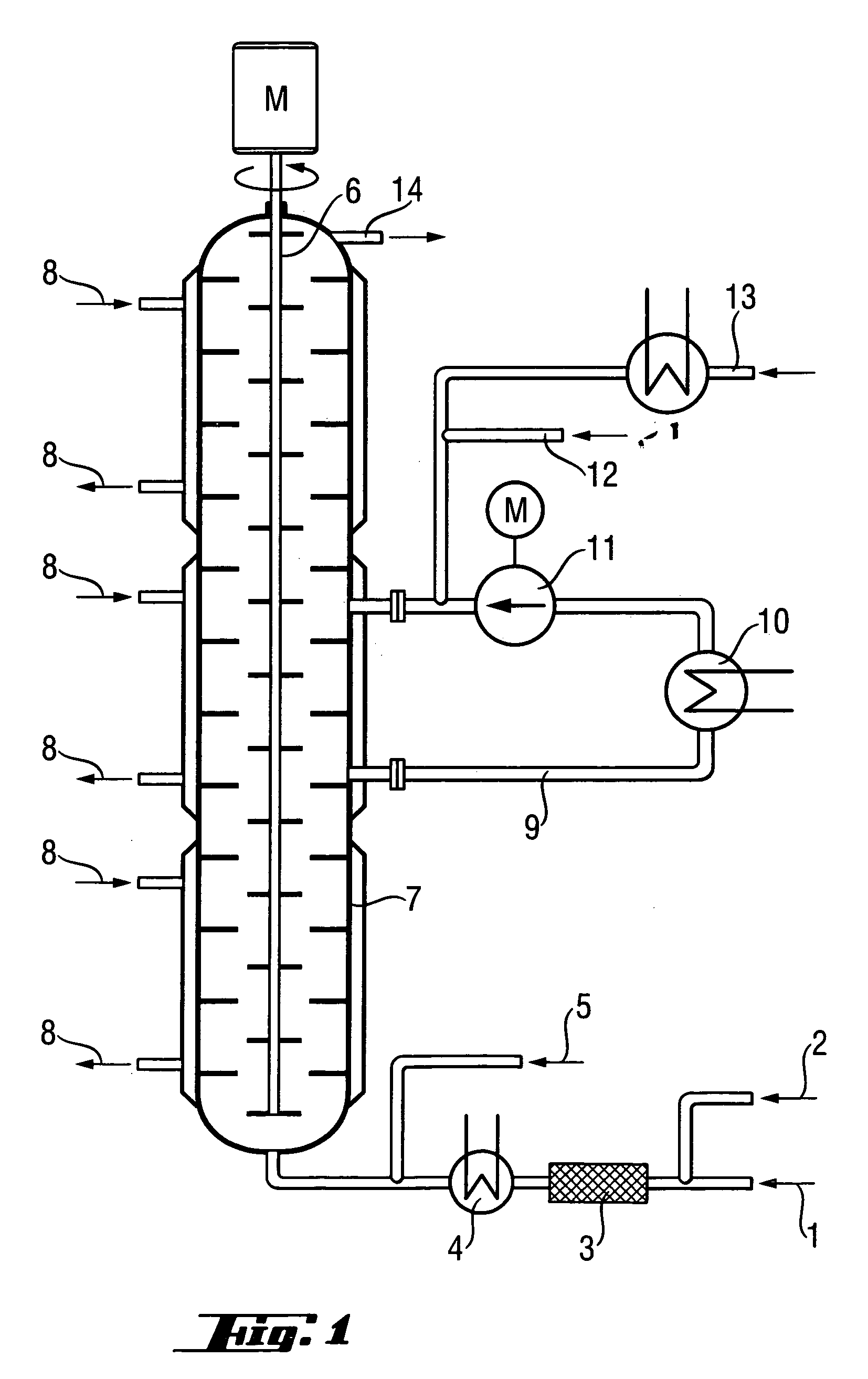Continuous hydrosilylation process
a technology of continuous hydrosilylation and process, which is applied in the direction of chemistry apparatus and processes, group 4/14 element organic compounds, organic chemistry, etc., can solve the problems of secondary reaction, incompletion reaction, and hot spots in reaction zon
- Summary
- Abstract
- Description
- Claims
- Application Information
AI Technical Summary
Benefits of technology
Problems solved by technology
Method used
Image
Examples
example 1
Loop-Tube Reactor According to the Invention
[0060]The reference numerals relate to FIG. 1. A mixture of hydrogenmethylpolysiloxane Me3SiO(HMeSiO)50SiMe3 (7.8 kg / h) and alpha-methylstyrene (2.6 kg / h) was passed through a cylindrical stainless steel tube (7) having three heating / cooling zones (V4A steel), an active stirrer (6), a length of 6.7 m and a nominal volume of 7000 ml.
[0061]A loop (9) including a heat exchanger (10) was located in the middle zone. 75 ml / h of a 1% strength by weight solution of hexachloroplatinic acid in isopropanol were introduced as catalyst solution into the loop (9) via a feed line (12). As second olefin component, 19.6 kg / h of 1-dodecene were metered in via feed line (12). The pump in the loop conveyed the reaction mixture at 150 l / h and the speed of rotation of the stirrer was 620 rpm. The reaction temperature was 136–142° C. in the entire reactor region. The product contained 2.3–2.6 mol % of unreacted SiH.
example 2
Tube Reactor Without Loop, Not According to the Invention
[0062]A cylindrical stainless steel tube (7) which was analogous to that in Example 1 but did not have a loop and instead had 2 additional introduction points, namely after (downstream of) the first zone and after (downstream of) the middle zone of the tube reactor was used. A mixture of hydrogenmethylpolysiloxane Me3SiO(HMeSiO)50SiMe3 (7.8 kg / h) and alpha-methylstyrene (2.6 kg / h) was metered in at the first introduction point at the beginning of the tube reactor (7). 25 ml / h of catalyst solution analogous to that in Example 1 was added at each of the three introduction points. As second olefin component, 1-dodecene was metered in in equal parts (each 9.8 kg / h) after the first and middle zones.
[0063]The reaction temperature was in the range from 100 to 190° C. Despite variation of cooling conditions and rates of introduction, the temperature in the middle cooling zone could not be reduced below 160° C., as a result of which pa...
example 3
Simulated Loop Reactor, Not According to the Invention
[0064]1000 g (13.1 mol) of allyl chloride together with 8 g of platinum catalyst (Pt(IV) chloride solution in C12-olefin having a platinum concentration of 1% by weight) are placed while stirring in a 5 l autoclave which is operated as a continuous stirred tank (simulation of a loop reactor) and the mixture is heated to 70° C. 2 mol of chlorosilane (Example 3a: methyldichlorosilane=232 g, Example 3b: trichlorosilane=273 g) are subsequently added until the exothermic reaction starts. After a further 11 mol of the chlorosilane (Example 3a: methyldichlorosilane=1276 g, Example 3b: trichlorosilane=1500 g) have been introduced and the parameters pressure and temperature are constant, the following continuous addition rates are set:[0065]1000 g of allyl chloride per hour[0066]8 g of platinum catalyst solution per hour (about 30 ppm)[0067]Example 3a=1500 g of methyldichlorosilane[0068]Target product=chloropropylmethyldichlorosilane[0069...
PUM
| Property | Measurement | Unit |
|---|---|---|
| temperatures | aaaaa | aaaaa |
| temperatures | aaaaa | aaaaa |
| temperatures | aaaaa | aaaaa |
Abstract
Description
Claims
Application Information
 Login to View More
Login to View More - R&D
- Intellectual Property
- Life Sciences
- Materials
- Tech Scout
- Unparalleled Data Quality
- Higher Quality Content
- 60% Fewer Hallucinations
Browse by: Latest US Patents, China's latest patents, Technical Efficacy Thesaurus, Application Domain, Technology Topic, Popular Technical Reports.
© 2025 PatSnap. All rights reserved.Legal|Privacy policy|Modern Slavery Act Transparency Statement|Sitemap|About US| Contact US: help@patsnap.com


